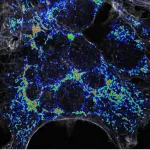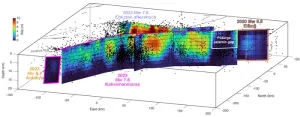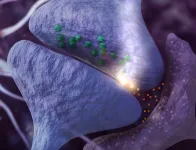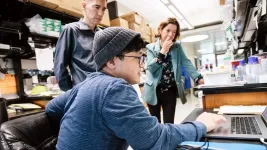(Press-News.org) LA JOLLA (April 20, 2023)—Scientists often act as detectives, piecing together clues that alone may seem meaningless but together crack the case. Professor Reuben Shaw has spent nearly two decades piecing together such clues to understand the cellular response to metabolic stress, which occurs when cellular energy levels dip. Whether energy levels fall because the cell’s powerhouses (mitochondria) are failing or due to a lack of necessary energy-making supplies, the response is the same: get rid of the damaged mitochondria and create new ones.
Now, in a study published in Science on April 20, 2023, Shaw and team cracked the case on this process of removal and replacement. It turns out that a protein called FNIP1 is the critical link between a cell sensing low energy levels and eliminating and replacing damaged mitochondria.
“This is a final puzzle piece that connects decades of studies from labs all over the world. It solves one of the final mysteries about how the signal to make new mitochondria is tied to the original signal that energy levels are low,” says Shaw, senior author and director of Salk’s Cancer Center. “This discovery that FNIP1 is at the heart of the metabolic stress response will help us understand healthy aging, cancerous tumors, neurodegenerative diseases, and so much more. This is a fundamental cellular process that ties into many diseases and will be in textbooks for years to come.”
Nearly 15 years ago, Shaw’s lab discovered that an enzyme called AMPK was responsible for starting the removal process of damaged mitochondria. Later, the team showed that a part of this removal process is the cell breaking damaged mitochondria into hundreds of fragments, then sorting through those fragments to remove the damaged parts and repurpose the functional parts. But the question remained—how is the repair of damaged powerhouses connected to the signal to start making new powerhouses from scratch?
When mitochondria are damaged, or when sugar (glucose) or oxygen levels fall in the cell, energy levels quickly fall. After an energy decrease as small as 10 percent, AMPK is triggered. AMPK communicates with another protein, called TFEB, to instruct genes to make 1) lysosomes (cellular recycling centers) to remove damaged mitochondria, and 2) replacement mitochondria. But how AMPK and TFEB communicated was unclear.
When a new suspect, FNIP1, joined in on the metabolic stress mystery, the answer was finally within reach. FNIP1 is the most recently discovered protein of the AMPK, TFEB, FNIP1 trio. For years, researchers were only able to connect FNIP1 to AMPK, and thus thought it may be a throwaway clue or a red herring—instead, it was the clue that cracked the case.
“Many years ago, we suspected the FNIP1 protein might be important for AMPK-TFEB communication that led to mitochondria synthesis and replacement in the cell during metabolic stress, but we didn’t know how FNIP1 was involved,” says first author Nazma Malik, a postdoctoral fellow in Shaw’s lab. “If correct, this finding would finally link AMPK and TFEB, which would both enrich our understanding of metabolism and cellular communication and provide a novel target for therapeutics.”
To determine whether FNIP1 was the missing link between AMPK and TFEB, the researchers compared unaltered human kidney cells with two altered types of human kidney cells: one that lacked AMPK entirely, and another that lacked only the specific parts of FNIP1 that AMPK talks to. The team discovered that AMPK signals FNIP1, which then opens the gate to let TFEB into the nucleus of the cell. Without FNIP1 receiving the signal from AMPK, TFEB remains trapped outside the nucleus, and the entire process of breaking down and replacing damaged mitochondria is not possible. And without this robust response to metabolic stress, our bodies—along with the many plants and animals whose cells also rely on mitochondria—would not be able to function effectively.
“Watching this project evolve over the last 15 years has been a rewarding experience,” says Shaw, holder of the William R. Brody Chair. “I am proud of my dedicated, talented team, and I cannot wait to see how this monumental finding will influence future research—at Salk and beyond.”
Other authors include Bibiana I. Ferreira, Pablo E. Hollstein, Stephanie D. Curtis, Elijah Trefts, Sammy Weiser Novak, Jingting Yu, Rebecca Gilson, Kristina Hellberg, Lingjing Fang, Arlo Sheridan, Nasun Hah, Gerald S. Shadel, and Uri Manor of the Salk Institute.
The work was supported by the National Institutes of Health (R35CA220538, P01CA120964, R01DK080425, NCI CCSG P30 CA014195, and R21 DC018237), the Leona M. and Harry B. Helmsley Charitable Trust (2012-PG-MED002), an American Heart Association and Paul G. Allen Frontiers Group award (19PABH134610000), the Salk Institute’s National Cancer Institute Cancer Center (CCSG P30 CA014195) and Nathan Shock Center for Aging Research (P30 AG068635), the Waitt Foundation, the National Science Foundation (NeuroNex award 2014862), and the Glenn Foundation.
About the Salk Institute for Biological Studies:
Unlocking the secrets of life itself is the driving force behind the Salk Institute. Our team of world-class, award-winning scientists pushes the boundaries of knowledge in areas such as neuroscience, cancer research, aging, immunobiology, plant biology, computational biology, and more. Founded by Jonas Salk, developer of the first safe and effective polio vaccine, the Institute is an independent, nonprofit research organization and architectural landmark: small by choice, intimate by nature, and fearless in the face of any challenge. Learn more at www.salk.edu.
END
Cracking the case of mitochondrial repair and replacement in metabolic stress
Salk scientists find protein FNIP1 links cellular powerhouse damage to repair during metabolic stress, with broad disease implications spanning from diabetes to cancer to neurodegeneration
2023-04-20
ELSE PRESS RELEASES FROM THIS DATE:
The climate crisis and biodiversity crisis can’t be approached as two separate things
2023-04-20
Human beings have massively changed the Earth system. Greenhouse-gas emissions produced by human activities have caused the global mean temperature to rise by more than 1.1 degrees Celsius compared to the preindustrial era. And every year, there are additional emissions of carbon dioxide, methane and other greenhouse gases, currently amounting to more than 55 gigatonnes of carbon dioxide equivalent. This unprecedented climate crisis has consequences for the entire planet – the distribution of precipitation ...
Economic growth alone is not enough to eliminate rabies
2023-04-20
Economic growth alone may not be enough to deliver the internationally agreed target to end human deaths from dog mediated rabies, according to new research from the University of Surrey. The study identifies that targeting vulnerable populations and improving responsible pet ownership are urgently needed to eradicate the deadly disease, which has strong associations with poverty.
In a landmark study, Surrey researchers investigated whether incidences of rabies are an inevitable consequence of poverty or whether other measures of development, such as healthcare access, can play a role in tackling this preventable disease.
Dr ...
PLOS Genetics to launch Microbial Section
2023-04-20
SAN FRANCISCO — PLOS today announced that PLOS Genetics is expanding the scope of its journal with a renamed section called Microbial Genetics. This section will replace the former Prokaryotic Genetics section to emphasize research on microbes more broadly with the aim to publish studies that use genetic approaches to provide insights into how bacteria as well as archaea and their phages/viruses, fungi (including yeasts and filamentous fungi), and protists function and interact with the biotic and abiotic world.
PLOS Genetics has an established presence in the fungal genetics community, but this ...
Moffitt researchers discover pathway critical for lymphoma development
2023-04-20
TAMPA, Fla. — MYC proteins are important regulators of cancer cell growth, proliferation and metabolism through their ability to increase the expression of proteins involved in these processes. Deregulation of MYC proteins occurs in more than half of all cancers and is associated with poor patient prognosis and outcomes. Numerous researchers have devoted significant efforts to try to target MYC proteins as a therapeutic approach to treat cancer. However, this has been extremely challenging to date, and other complementary strategies are being investigated.
In a new article in Blood Cancer Discovery, which was published simultaneously with a presentation ...
Water arsenic including in public water is linked to higher urinary arsenic totals among the U.S. population
2023-04-20
April 20, 2023-- A new study by researchers at Columbia University Mailman School of Public Health shows that water arsenic levels are linked to higher urinary arsenic among the U.S. population for users of both private wells and public water systems. The findings are published in the journal Environmental Research.
Long-term exposure to arsenic even at low and moderate levels can increase the risk of cancer and other types of chronic disease. While drinking water along with diet is a major source ...
UHN Researchers publish ground breaking clinical trial in lung transplantation
2023-04-20
(Toronto, April 20, 2023) Storing donor lungs for transplant at 10 degrees Celsius markedly increases the length of time the organ can live outside the body according to research led by a team of scientists at the Toronto Lung Transplant Program in the Ajmera Transplant Centre at the University Health Network (UHN).
The prospective multicenter, nonrandomized clinical trial study of 70 patients demonstrated that donor lungs remained healthy and viable for transplant up to four times longer compared ...
Turkey’s next quake: USC research shows where, how bad — but not ‘when’
2023-04-20
Researchers know a lot about Turkey’s next major earthquake. They can pinpoint the probable epicenter, estimate its strength and see the spatial footprint of where damage is most likely to occur.
They just can’t say when it will happen.
That’s the main takeaway from a new USC-led study that appears today (April 20) in Seismica.
Using remote sensing, USC geophysicist Sylvain Barbot and his fellow researchers documented the massive Feb. 6 quake that killed more than 50,000 people in Eastern Turkey and toppled more than 100,000 buildings.
Alarmingly, researchers found that a section of the fault remains unbroken and locked – a sign that the plates there ...
Astrocyte dysfunction causes cognitive decline
2023-04-20
People with dementia have protein build-up in astrocytes that may trigger abnormal antiviral activity and memory loss, according to a preclinical study by a team of Weill Cornell Medicine investigators.
Dysfunction in cells called neurons, which transmit messages throughout the brain, has long been the prime suspect in dementia-related cognitive deficits. But a new study, published in Science Advances on April 19, suggests that abnormal immune activity in non-neuronal brain cells called astrocytes is sufficient to cause cognitive deficits in dementia. The discovery could lead to new treatments that reduce excess immune activity in astrocytes and their detrimental effects on other brain ...
UC Irvine biologists discover bees to be brew masters of the insect world
2023-04-20
Irvine, Calif., April 20, 2023 — Scientists at the University of California, Irvine have made a remarkable discovery about cellophane bees – their microbiomes are some of the most fermentative known from the insect world. These bees, which are named for their use of cellophane-like materials to line their subterranean nests, are known for their fascinating behaviors and their important ecological roles as pollinators. Now, researchers have uncovered another aspect of their biology that makes them even more intriguing.
According to a study published in Frontiers in Microbiology, cellophane ...
Sugar rush: scientists discover key role of glucose in brain activity
2023-04-20
SAN FRANCISCO, CA—April 18, 2023—The human brain has a sweet tooth, burning through nearly one quarter of the body’s sugar energy, or glucose, each day. Now, researchers at Gladstone Institutes and UC San Francisco (UCSF) have shed new light on exactly how neurons—the cells that send electrical signals through the brain—consume and metabolize glucose, as well as how these cells adapt to glucose shortages.
Previously, scientists had suspected that much of the glucose used by the brain was metabolized by other brain cells called ...
LAST 30 PRESS RELEASES:
Making lighter work of calculating fluid and heat flow
Normalizing blood sugar can halve heart attack risk
Lowering blood sugar cuts heart attack risk in people with prediabetes
Study links genetic variants to risk of blinding eye disease in premature infants
Non-opioid ‘pain sponge’ therapy halts cartilage degeneration and relieves chronic pain
AI can pick up cultural values by mimicking how kids learn
China’s ecological redlines offer fast track to 30 x 30 global conservation goal
Invisible indoor threats: emerging household contaminants and their growing risks to human health
Adding antibody treatment to chemo boosts outcomes for children with rare cancer
Germline pathogenic variants among women without a history of breast cancer
Tanning beds triple melanoma risk, potentially causing broad DNA damage
Unique bond identified as key to viral infection speed
Indoor tanning makes youthful skin much older on a genetic level
Mouse model sheds new light on the causes and potential solutions to human GI problems linked to muscular dystrophy
The Journal of Nuclear Medicine ahead-of-print tip sheet: December 12, 2025
Smarter tools for peering into the microscopic world
Applications open for funding to conduct research in the Kinsey Institute archives
Global measure underestimates the severity of food insecurity
Child survivors of critical illness are missing out on timely follow up care
Risk-based vs annual breast cancer screening / the WISDOM randomized clinical trial
University of Toronto launches Electric Vehicle Innovation Ontario to accelerate advanced EV technologies and build Canada’s innovation advantage
Early relapse predicts poor outcomes in aggressive blood cancer
American College of Lifestyle Medicine applauds two CMS models aligned with lifestyle medicine practice and reimbursement
Clinical trial finds cannabis use not a barrier to quitting nicotine vaping
Supplemental nutrition assistance program policies and food insecurity
Switching immune cells to “night mode” could limit damage after a heart attack, study suggests
URI-based Global RIghts Project report spotlights continued troubling trends in worldwide inhumane treatment
Neutrophils are less aggressive at night, explaining why nighttime heart attacks cause less damage than daytime events
Menopausal hormone therapy may not pose breast cancer risk for women with BRCA mutations
Mobile health tool may improve quality of life for adolescent and young adult breast cancer survivors
[Press-News.org] Cracking the case of mitochondrial repair and replacement in metabolic stressSalk scientists find protein FNIP1 links cellular powerhouse damage to repair during metabolic stress, with broad disease implications spanning from diabetes to cancer to neurodegeneration




